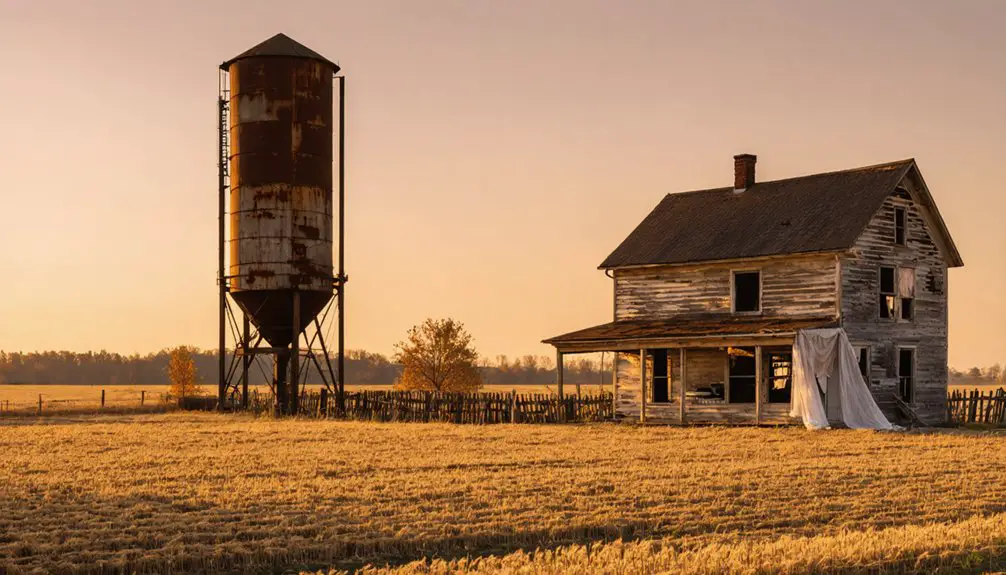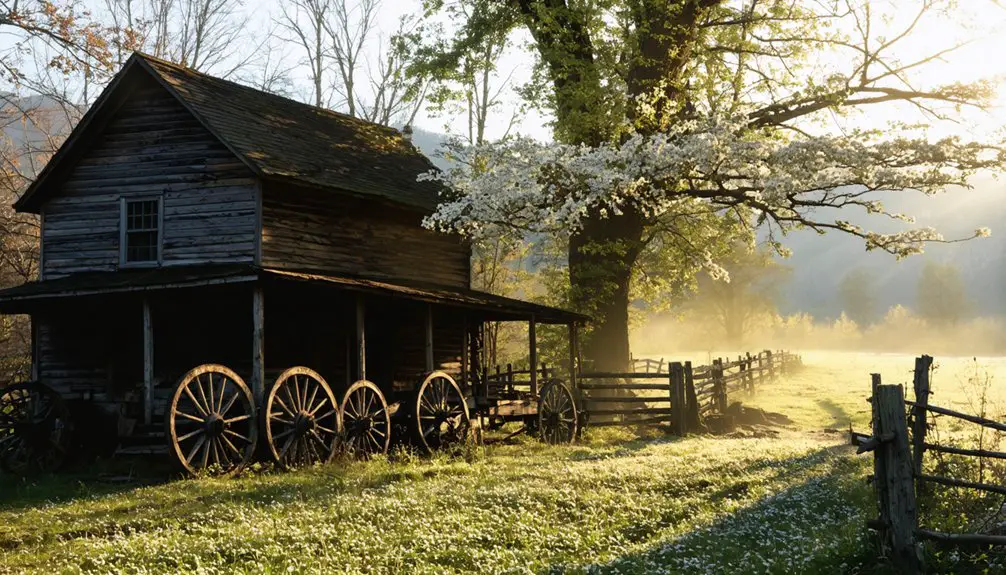You’ll find Wheat, Tennessee’s haunting history in the shadows of Oak Ridge, where a thriving rural community once flourished. In 1942, the Manhattan Project forced 3,000 residents to abandon their homes, farms, and nationally-renowned peach orchards with just 30 days’ notice. Today, only the George Jones Memorial Baptist Church stands as a silent witness to this displaced community, while mysterious footsteps and spectral encounters echo through the abandoned landscape.
Key Takeaways
- Wheat, Tennessee was a thriving rural community established in 1794 and known for its Grade-A peach production and agricultural success.
- The town featured McKinney General Store, multiple churches, and George Jones Memorial Baptist Church, serving approximately 1,000 families.
- In December 1942, residents were forced to evacuate with 30-day notice for a government project, ending the town’s existence.
- George Jones Memorial Baptist Church remains the only original building, now preserved as a National Historic Place.
- The abandoned town site reportedly experiences paranormal activity, with documented sightings of spirits and unexplained phenomena.
The Birth of Bald Hill Settlement
While treaties like the Holston Agreement of 1791 and Tellico Treaty of 1798 opened up portions of Tennessee for settlement, the area that would become Wheat began as a remote outpost known as Bald Hill.
Land seizures and encroachment by settlers into Native American territories had become increasingly common, setting the stage for new frontier communities like Bald Hill.
Bald Hill’s origins trace back to 1794 when Elias Roberts, traveling from South Carolina, became one of the area’s pioneering settlers. By 1799, he’d secured 500 acres along Poplar Creek and the Clinch River, establishing a significant foothold in the region.
The settlement’s name stemmed from the extensive timber harvesting that stripped the surrounding hills bare. Early landowners capitalized on this natural resource, floating logs down the rivers to distant sawmills. The community’s identity evolved when Henry Franklin Wheat established the local post office in 1881.
You’ll find that this strategic location, with its fertile valleys and essential waterways, proved instrumental in transforming the wilderness into a thriving community.
Early Pioneers and Cherokee Treaties
You’ll find that early settlers in the Bald Hill area were able to establish permanent homesteads only after a series of Cherokee treaties ceded the land to white settlement in the late 1700s and early 1800s.
The Roberts family, among the first pioneers, established their settlement along the river during this period of change when treaties like those signed at Tellico formalized settler claims on previously Cherokee territory.
The Cherokee leaders received $1600 in compensation under the Fourth Treaty of Tellico in 1805 when ceding additional lands in the region.
These agreements, though often controversial and obtained through pressure on Cherokee leaders, opened the way for more extensive settlement in what would become the Wheat community, even as some Cherokee rights to certain resources were temporarily preserved.
The First Treaty of Tellico in 1798 was particularly significant as it granted settlers the land between the Clinch River and Cumberland Plateau.
Treaty-Enabled Settlement Expansion
Through a series of pivotal treaties in the early 1800s, Tennessee’s frontier regions opened for pioneer settlement as Cherokee lands transferred to United States control.
You’ll find that the Third Treaty of Tellico (1805) had far-reaching treaty implications, transferring Cherokee territory north of Duck River and east to the Tennessee River to U.S. jurisdiction.
The Treaty of the Holston (1791) established protected navigation rights and road construction while nominally safeguarding Cherokee interests. Despite the treaty’s stated goal of perpetual peace, violations and violence between settlers and Cherokee occurred within months of its signing.
Land dispossession accelerated dramatically under the controversial Treaty of New Echota (1835), which, despite representing only 10% of Cherokee consent, finalized removal plans.
Under Andrew Jackson’s administration, nearly seventy removal treaties displaced approximately 50,000 eastern Indians, fundamentally reshaping Tennessee’s frontier landscape and enabling widespread pioneer expansion. The permanent settlers had begun arriving in the region during the late 1760s, establishing early communities and trade relationships with native populations.
Native Land Negotiations
Before the establishment of Wheat, extensive negotiations between Cherokee leaders and early pioneers shaped the region’s settlement patterns.
You’ll find that Cherokee treaties evolved from early colonial agreements into more complex land arrangements, though settler encroachment remained a persistent challenge. Many early treaties involved deerskin and slave trade between Cherokee towns and English traders.
The 1817 treaty established land cession boundaries through significant geographical markers like rivers and ridges. Key developments in these native land negotiations included:
- The 1775 Treaty of Sycamore Shoals, which transferred vast territories to the Transylvania Land Company despite its questionable legality
- Washington negotiations in 1806 that allowed for specific government buildings while preserving Cherokee ferry rights
- The 1817 treaty with Andrew Jackson that formalized boundary lines and required a detailed Cherokee census
These agreements gradually transformed the landscape you see today, though they often favored settler interests over Cherokee territorial rights, leading to increasing pressure on native lands.
Roberts’ River Settlement
Pioneer leader James Robertson spearheaded the establishment of Roberts’ River Settlement in 1779, marking a pivotal expansion of Cumberland territory settlements. With an initial party of nine men and one negro fellow, they planted corn and secured the area before bringing their families to settle along the Cumberland River’s bluffs.
Robertson’s experience from the Watauga Association proved invaluable in organizing the new settlement. You’ll find that Roberts’ River settlement governance fell under the Cumberland Compact of 1780, which settlers modeled after the Watauga Association’s system. The settlement’s foundation rested on land acquired through the Transylvania Company following Cherokee cessions.
Fort Nashborough provided essential protection, while settlers like John Rains and Amos Eaton established nearby outposts. The settlement thrived through sustainable agriculture and strategic defensive measures, with additional pioneers from South Carolina, including Buchanan and Mulherrin families, strengthening the community. The Fort Prince George supply route from Charleston helped sustain early settlements in the region.
From Bald Hill to Wheat: A Community Transforms
Following treaties with the Cherokee in the 1790s, European American settlers established a thriving community they called Bald Hill, named for the bare hillsides stripped of timber for regional sawmills.
You’ll find rich historical significance in how this settlement evolved its community identity in 1881 when Henry Franklin Wheat became the first postmaster, prompting residents to rename their town in his honor.
Key developments that shaped Wheat’s emergence:
- Levi Henderson Wheat’s early influence as a founding landowner since 1805
- Post office establishment marking formal recognition and improved commerce
- Agricultural success, particularly in Grade-A peach production
The shift from Bald Hill to Wheat reflected the growing prominence of the Wheat family and their lasting impact on local development, establishing a stronger sense of place for residents.
Life in the Thriving Rural Town

You’d find a bustling commercial center in Wheat at the McKinney General Store, where residents gathered for essential supplies and social interaction.
The community’s social fabric was woven through multiple churches serving various denominations, while the local Masonic Lodge hosted fraternal gatherings and civic events.
Local stores, mills, and a filling station kept the town’s daily commerce flowing, serving the needs of roughly 1,000 families who called Wheat their home.
Daily Commerce Activities
Three distinct economic pillars shaped daily life in the thriving town of Wheat, Tennessee: agriculture, retail commerce, and crucial services.
You’d find a bustling local trade scene centered around farming and orchards, with Grade-A peaches earning regional recognition. The Clinch River supported both agricultural and timber operations, while general stores like M.E. Trew’s served as crucial community hubs. Seasonal markets flourished as farmers brought their produce to town.
- The M.E. Trew General Merchandise Store offered everything from groceries to fabric, becoming a social gathering spot.
- Multiple general stores provided crucial supplies, reducing the need for long-distance travel.
- A post office, service station, and Masonic Lodge supported daily commerce and community life.
The workforce included farmers, merchants, educators, and service providers, creating a self-sustaining rural economy.
Community Gatherings and Events
Life in Wheat, Tennessee revolved around vibrant community gatherings that strengthened social bonds and preserved cherished traditions.
You’d find your neighbors at the McKinney General Store sharing daily news, or attending services at George Jones Memorial Baptist Church. The town’s social fabric was woven through its schools, where community storytelling flourished during events and homecomings.
Even after the town’s displacement in 1947, Wheat’s social resilience shone through as former residents gathered every first Sunday in October to celebrate their heritage.
You’d experience the rhythms of rural life through seasonal agricultural celebrations, from peach harvests to honey collection. The Masonic Lodge and various churches provided spaces for civic engagement, while school events and homecomings became cherished traditions that continue to honor Wheat’s legacy.
Agricultural Heritage and the Famous Peach Orchards
While many Tennessee towns were known for their diverse agriculture, Wheat’s claim to fame rested largely on its seven major peach orchards that shaped the community’s identity and economy.
The region’s peach cultivation practices were sophisticated, with carefully graded fruits shipped nationwide via rail from nearby Dyllis. You’ll find the legacy of these agricultural practices woven into the very fabric of the community’s history.
The orchards’ impact on Wheat’s development was significant:
- The Dyllis Orchard Company operated the largest operation, managing distribution across the country
- Grade A peaches were shipped to Cincinnati, while local markets received the remaining harvest
- Families maintained smaller orchards for personal use, supporting a self-sufficient lifestyle
These orchards didn’t just sustain the economy; they defined Wheat’s character until its eventual transformation into modern-day development.
The Heart of Faith: George Jones Memorial Baptist Church

Standing as the sole survivor of Wheat’s original structures, the George Jones Memorial Baptist Church represents more than just a historical landmark – it embodies the enduring spirit of a displaced community.
You’ll find this three-bay brick building, crowned with a distinctive bell tower, perched on a gentle rise along the old State Route 61. Originally founded in 1854 as Mount Zion Baptist Church, it’s been a beacon of faith legacy since its renaming in 1901.
Despite the community’s forced dissolution in 1942 for the Manhattan Project, the church’s resilience shines through its annual homecomings, where former residents gather every October.
Today, under Department of Energy preservation, this National Historic Place continues to tell the story of Wheat’s community resilience and unwavering spiritual foundation.
Manhattan Project and the 30-Day Notice
When the United States government selected Wheat as an essential site for the Manhattan Project in 1942, residents received an abrupt 30-day notice to vacate their homes and businesses.
This sudden displacement was part of a broader effort to establish what would later become the Manhattan Project National Historical Park, encompassing sites in Tennessee, New Mexico, and Washington.
Today’s 30-day transparency requirements guarantee better communication about changes to these historic sites:
- The Department of Energy and National Park Service work together to preserve Manhattan Project heritage
- Public notices in the Federal Register announce any new agreements or land transfers
- Historic preservation efforts protect the stories of displaced communities like Wheat
You’ll find that while the original eviction notice brought heartache to Wheat’s residents, modern regulations help protect both history and community interests.
The Forced Exodus of 1942
The December 1, 1942 government order shattered the peaceful existence of Wheat’s residents, forcing approximately 3,000 people to abandon their homes, farms, and businesses within a month’s time.
In a single month, wartime necessity crushed an entire community, uprooting thousands from the only homes they’d ever known.
You’d have witnessed families frantically loading their belongings onto horse-drawn buggies, knowing they’d never return to their ancestral lands.
Despite the community’s resilience, the government’s meager compensation of $45-75 per acre couldn’t replace generations of cultural memory built into Wheat’s churches, schools, and gathering places.
Families watched as their Grade-A peach farms, the cornerstone of their economic livelihood, were stripped away.
While most structures were demolished, the George Jones Memorial Baptist Church stands as a lone sentinel, preserving the memory of a close-knit community destroyed by wartime priorities.
Preserving Memories Through Annual Reunions
Since 1947, displaced residents of Wheat have gathered annually on the first Sunday of October to preserve their cherished memories and community bonds through “Homecoming” reunions.
You’ll find these gatherings serve as powerful platforms for memory sharing and community bonding, where descendants and volunteers organize activities that keep Wheat’s legacy alive despite geographic dispersion.
These reunions offer:
- Memorial services and photograph sharing that document local history
- Educational forums highlighting Wheat’s agricultural heritage and the impact of the 1942 displacement
- Opportunities for collective healing and honoring ancestors
Though the original town site remains within restricted federal land, you’re witnessing how these gatherings maintain cultural continuity through storytelling, institutional memory, and emotional connections that transcend physical boundaries.
Wheatlands Plantation: A Haunted Connection
Located in Sevierville, Tennessee, Wheatlands Plantation stands as a haunting memorial to both agricultural prosperity and human tragedy.
From the Federal-style brick home built in 1825 to its sprawling 3,700 acres, you’ll discover a site steeped in haunted history spanning seven generations of the Chandler family.
The plantation’s dark past includes over 70 documented deaths, Civil War conflicts, and the somber presence of both slave and Cherokee burial grounds.
Today, visitors report frequent spectral encounters: disembodied voices echo through halls, mysterious footsteps traverse staircases, and apparitions of soldiers and a woman in white materialize without warning.
While preservation efforts have uncovered archaeological treasures and historic documents, Wheatlands’ supernatural legacy persists, offering a chilling glimpse into East Tennessee’s complex antebellum heritage.
Frequently Asked Questions
What Happened to the Displaced Residents After Leaving Wheat?
Your ancestors joined 3,000 displaced families who scattered to nearby towns, struggling with inadequate $45-75/acre compensation. You’ll find they maintained community bonds through annual Homecoming gatherings starting in 1947.
Are There Any Surviving Photographs of Wheat Before Its Demolition?
You’ll find numerous surviving photographs showing Wheat’s historical significance, including church gatherings, stores, and a notable 1945 aerial view that provides photographic evidence of the community’s final agricultural days.
How Much Compensation Did Residents Receive for Their Seized Property?
While you’d have legal rights to fair property value under Tennessee law, exact compensation records for individual residents haven’t been preserved. Local families likely faced compensation disputes during the forced relocation.
Did Any Families Successfully Resist or Delay the Forced Relocation?
You won’t find historical accounts of successful family resistance to this relocation. While some families may have stayed longer than others, federal authorities ultimately forced everyone to leave their land.
What Artifacts From Original Wheat Buildings Have Been Preserved Today?
While you’d expect more from a historic town, only the George Jones Memorial Baptist Church remains as an original artifact. The town’s historical significance lives on through preserved cemeteries and burial grounds.
References
- https://nashvilleghosts.com/haunted-wheatlands-plantation/
- https://24ijhill.wixsite.com/oshsnews/post/lost-communities-of-tennessee-wheat
- https://k25atomichistorycenter.org/happy-valley/wheat.html
- https://en.wikipedia.org/wiki/George_Jones_Memorial_Baptist_Church
- https://www.ghosttowns.com/states/tn/wheat.html
- https://my.vanderbilt.edu/tennesseehistory/tennessee-history/
- https://www.tngenweb.org/wilson/sketch.htm
- https://en.wikipedia.org/wiki/Tennessee
- https://www.srs.fs.usda.gov/pubs/misc/nesbitt.pdf
- https://tennesseeencyclopedia.net/entries/treaties/



